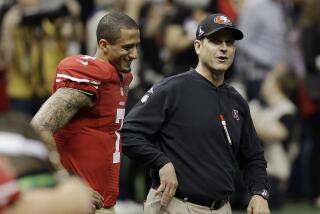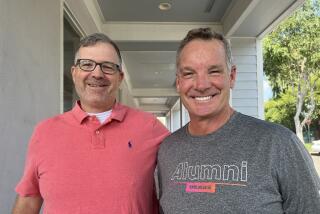Kemp Scores Touchdown of Sorts With GOP Ticket
- Share via
SAN DIEGO — As a kid in school, Jack Kemp read thick history and philosophy books when others his age were reading comic books. Yet his intense interest in learning seldom resulted in good grades.
As a member of Congress representing suburban Buffalo, N.Y., in the 1970s and 1980s, Kemp sowed the first seeds of what would become the 1994 “Republican revolution.” But he left it to Newt Gingrich and other GOP upstarts to bring his vision to fruition.
And when he took control of the Department of Housing and Urban Development under President Bush, Kemp proved a tireless advocate for housing renewal. But the results of his efforts to convert ideas into bricks-and-mortar improvements for real people were less than spectacular.
Repeatedly during his 61 years--from his childhood in Los Angeles to his days as a pro football quarterback and, later, throughout his spectacular rise in politics--the GOP vice presidential nominee has been known as a big thinker. He has distinguished himself by his zealous, almost evangelical, advocacy of innovative ideas--the more complex, the better.
At the same time, virtually everyone who has ever known Kemp says he is usually too impatient, too undisciplined to put his ideas to work.
Perhaps it is just a coincidence that his personal style can be summed up by a sports analogy. In life, as in football, Kemp often has shown a preference for turning to a passing attack when it might have been wiser to grind out the yardage on the ground.
Kemp’s nomination satisfies his long-held, burning desire for a national platform--a goal he set for himself a quarter-century ago when he left behind the cheering Buffalo Bills fans and set out to win plaudits on the field of politics.
But even as Republicans applaud the glamour he brings to the GOP ticket, admirers and critics alike quietly ask whether the signal-caller who liked to pass would function effectively as vice president, a job that offers little more than short yardage.
A friend, Rep. Nancy L. Johnson (R-Conn.), sees Kemp’s ideological fervor as complementing presidential nominee Bob Dole’s natural pragmatism and instinct for compromise. “I think they’ll have a real exchange of ideas,” she said. “I didn’t want Bob Dole to choose a look-alike.”
Other Kemp watchers are not so charitable.
“I always found him very willing to listen and very hard to persuade,” said Cushing N. Dolbeare, an advocate for low-income housing who met frequently with Kemp at HUD. “He’s very enthusiastic about things. And the more you argue with him, the more enthusiastic he gets.”
A YOUTHFUL LESSON: Competing With the Big Guys
A black-and-white photograph shows a 300-pound defensive lineman bearing down on the quarterback, who seems destined to be ground into the muddy field. For years Kemp displayed this picture on the wall next to his desk.
Kemp, the quarterback in that American Football League championship game in 1963, not only avoided obliteration but unleashed a bomb--which turned into a touchdown.
“It simply says that a little guy can compete against a big guy if you’ve got elan vital, if you’ve got the spirit, if you’ve got some spunk,” Kemp said. “That’s my philosophy.”
This notion melds the lessons of both his football career and his Los Angeles youth. It is a philosophy that was instilled in Kemp in his family’s Spanish-style bungalow on North Plymouth Boulevard one block south of Clinton Street, and later, in a two-story home on Ridgewood Place, both just east of Larchmont Village.
Born on July 13, 1935, Jack French Kemp was the third of four sons of Paul R. Kemp, the owner of a small trucking company in downtown Los Angeles, and Frances Pope Kemp, a social worker. His parents were Republicans.
At the dinner table, Frances Kemp insisted her sons grapple with important issues. “It was,” said Kemp’s younger brother, Dick, “a family where ideas mattered, and concepts were important.”
“We were always very argumentative, very contentious, not in a nasty way, but in trying to learn from each other,” said Tom Kemp, an older brother. “With Dad, it was unconditional love. With Mother, it was the intellectual challenge and expecting her boys to do great things.”
From their father, they learned about people. The four Kemp boys were often at their father’s side, driving trucks or loading them on the gritty docks. Quickly, they learned about hard work and racial tolerance.
“My father’s company was small--only about six drivers--but one or two were black, and we drove together with them,” Tom Kemp said. “They were our friends. I think that experience, along with football--in football, Jack as the quarterback was dependent upon his teammates--made Jack see that a true economic program has to be one of the good shepherd lifting up everyone and leaving no one behind.”
Jack Kemp was a member of the 1953 Fairfax High School graduating class, a group that included musician Herb Alpert, Dodger pitcher Larry Sherry and Los Angeles radio announcer Don Elliott.
In the early 1950s, Elliott says, the school’s population of 2,100 students was largely Jewish. At the time, the Holocaust was a horrid chapter in very recent history, and Kemp became a strong supporter of Jewish causes in his later life.
At Occidental College, Kemp became the archetype of the football hero. He wore a crew cut. He drove a red MG. His team wasn’t a national powerhouse, but it ran up a 50-point margin against Stanford University one year.
The team’s halfback, Mike Quint, now an insurance broker in Laguna Niguel, recalls emerging with Kemp one day from a class on the history of civilization. Kemp insisted that Quint introduce him to a blond student one year his junior.
That student was Joanne Main, now Joanne Kemp. They have four children--one son, Jeff, quarterbacked for several NFL teams, including the Los Angeles Rams--and 11 grandchildren.
For all his competitive zeal, Kemp did not push himself in class, Quint says. “He wasn’t a very dedicated student,” Quint said. “But he was always very bright, so he got by.”
Indeed, Quint says, Kemp’s passion for learning seemed to burn brightest in the isolated world of books. He consumed them with an enthusiasm that still impresses Quint.
“I would go to class with him, and he would start talking about [conservative] German economists like [Ludwig] von Mises and [Friedrich August] von Hayek,” Quint said.
Kemp was graduated from Occidental in 1957 with a degree in physical education. An Army reservist, he was assigned to a unit called to active duty during the 1961 Berlin crisis. But although he could play professional football, Kemp flunked an Army medical exam because of a shoulder injury.
“He did continue as a football player because the standards for active duty in the Army were more stringent than they were for playing in the American Football League in those days,” said John Buckley, communications director for the Dole-Kemp campaign. “. . .If you could put your football helmet on, they were going to put you into the game.”
A 17th-round draft pick of the Detroit Lions, Kemp was released before the 1957 season began. Cut by five subsequent teams in the United States and Canada, he was signed by the Los Angeles Chargers in 1960--the American Football League’s inaugural year. Kemp moved with the franchise to San Diego shortly afterward, heaving passes for an annual salary of $11,500, which eventually rose to $50,000 when he played for the Buffalo Bills.
In a locker room full of jocks, Kemp read Thoreau and other philosophers. Coach Lou Sabin once admonished him: “Get rid of that darn book and get your mind on the game.”
Kemp developed a reputation for independence that would follow him through life. Sabin benched him more than once for his transgressions.
“Jack was strong-willed. He’d come into a huddle and say, ‘The coach wants us to do this. But forget that.’ And he’d call his own play,” said Al BeMiller, who played center.
As a founder of the union representing players in the AFL, Kemp also became a mediator and an advocate of equal treatment of black players in salary and other issues.
Meanwhile, he was developing political instincts--raw and more theoretical than practical. That led to an off-season job writing editorials for the San Diego Union, whose editor, Herb Klein, had worked on Richard Nixon’s unsuccessful 1960 presidential campaign. When Nixon, out of office, would call on Klein at his house for a Sunday afternoon chat, Klein would often include Kemp in the conversation.
In 1966, Kemp assisted Nixon as he campaigned for Republican congressional candidates. A year later, Kemp worked for then-Gov. Ronald Reagan as a liaison to local and county governments.
It was only a matter of time before he became a candidate himself.
PASSAGES: From Football to Congress Ignoring the Boos
When the Bills were playing at home and trailing at halftime, Coach Sabin would advise his players to leave the locker room in the second half with their helmets already on. That would protect them from the beer cans that the fans were sure to heave at them.
Buffalo’s raucous fans may well have prepared Kemp for politics. Said brother Dick: “You are talking about a guy who would have to walk on a football field and hear 80,000 people booing him.
“What people think around him is not the driving force. . . ,” he said. “There is an engine that is stronger than that at work.”
By 1970, with his football career ended by an injury, Kemp turned immediately to politics. With a little help from the Nixon White House, he was narrowly elected to Congress from a district encompassing a mix of affluent communities and struggling blue-collar neighborhoods. His political base was Hamburg, N.Y., just a short drive from the stadium where the Bills still play. “A commanding man,” his campaign brochure called him. It included no sports photographs and made no mention of his football career.
In Congress, as in football, his ideas and his unrelenting quest for recognition set him apart from his colleagues.
“Jack rose to be a major national political figure and somebody considered as a presidential candidate on the strength of his personality and drive and ideas,” said Norman J. Ornstein of the American Enterprise Institute, a conservative think tank in Washington. “That’s not something that happens very often for House members.”
In the House, Kemp is remembered as one of the first of many restless young Republicans who challenged the party’s older leaders, who were inclined to cooperate with the Democratic majority.
He became the ideological model for Gingrich and many other GOP members, who were dissatisfied with being in a permanent minority and sought a national audience to challenge the liberalism of the House Democratic leadership. At the same time, Kemp steered clear of the highly partisan rhetoric favored by most of his compatriots.
“Democrats all liked him,” said Rep. Patricia Schroeder (D-Colo.), a liberal who disagreed with Kemp on many issues.
Among the ideas that Kemp boldly espoused as his own: creating a North American free trade zone, establishing urban enterprise zones, letting tenants own public housing and supporting the Nicaraguan rebels.
Kemp combined his conservative economic ideas with an equally passionate desire to help minorities and the poor--a remnant of what he had learned from working for his father. He also broke with his conservative colleagues on labor issues, reflecting his experience as a member of the National Football Players Assn.
Still a reader, Kemp seized on the ideas of conservative intellectuals then outside the Washington power structure, frequently contacting them to exchange ideas. Among them was Jude Wanniski, then an editorial page editor at the Wall Street Journal, who would become the leading guru of supply-side economics.
Wanniski recalls that when they first met in Kemp’s office in 1976, the congressman bounded out of his chair, enveloped him in a force field of enthusiasm and initiated a conversation that moved to Kemp’s home in Maryland and lasted into the night.
Wanniski’s influence helped lead Kemp to espouse the Kemp-Roth tax bill, a 30% cut in tax rates over three years, which was enacted in 1981 as part of President Reagan’s economic program.
Colleagues, however, do not recall Kemp as a top-notch legislator.
Then-Minority Leader Robert H. Michel (R-Ill.), whose laid-back, bipartisan style rankled the House GOP’s young Turks, says that Kemp’s disdain for detail and practical execution made him a weak lawmaker. And, he says, Kemp’s frequent economic harangues wore on his colleagues.
WORKING FOR CHANGE: A Presidential Bid: Aiming High
Kemp, his political aspirations growing faster than his abilities, stands before an Iowa audience as a candidate for the 1988 GOP presidential nomination. He is delivering a long, boring speech about urban enterprise zones and nuclear weapons defenses. The issues could not be of less interest to the rural gathering.
Exasperated by such performances, his advisors later posted a list of subjects for him to eliminate from his stump speech: author Hannah Arendt, the Malthusian theory and the gold standard.
Some Republicans had sought to exploit Kemp’s star quality, pleading with him to take the next logical step in politics by running for the Senate or for governor of New York. He refused.
Instead of moving gradually up the ladder, Kemp began promoting himself as early as 1980 as a possible vice presidential nominee. And in 1988, with Reagan leaving the White House, he mounted his presidential campaign.
Kemp never connected with voters. He finished poorly in the first contest, the Iowa caucuses, and folded his campaign shortly after. Aides said he was unwilling to lower himself to take on the basic chores of campaigning: raising money and disciplining himself to stay “on message.” He wound up abandoning his House seat for nothing.
Kemp’s presidential bid ran afoul of the Federal Election Commission, which found that the campaign had received more than $750,000 in improper donations and $13,000 in prohibited corporate contributions. He was fined $120,000.
When George Bush became president in 1989, he persuaded Kemp to take the post of HUD secretary. Inheriting a poorly managed, scandal-ridden department, Kemp instituted reforms, touted urban renewal, visited numerous public-housing projects and invited low-income people into his office.
Espousing tenant ownership of public housing, he often visited a handful of showcase projects where the concept had succeeded in improving conditions. But experts say Kemp oversold the concept. Even when low-income residents can acquire the units at no cost, they usually do not have enough money for upkeep. Of the nation’s 1.2 million public-housing units, 2,675 have been approved for sale, but only 200 have actually sold.
*
This story was reported by Greg Krikorian, Marc Lacey, Alan C. Miller, Michael Hiltzik, Sara Fritz and James Gerstenzang. It was written by Fritz and Gerstenzang.
More to Read
Get the L.A. Times Politics newsletter
Deeply reported insights into legislation, politics and policy from Sacramento, Washington and beyond. In your inbox three times per week.
You may occasionally receive promotional content from the Los Angeles Times.










